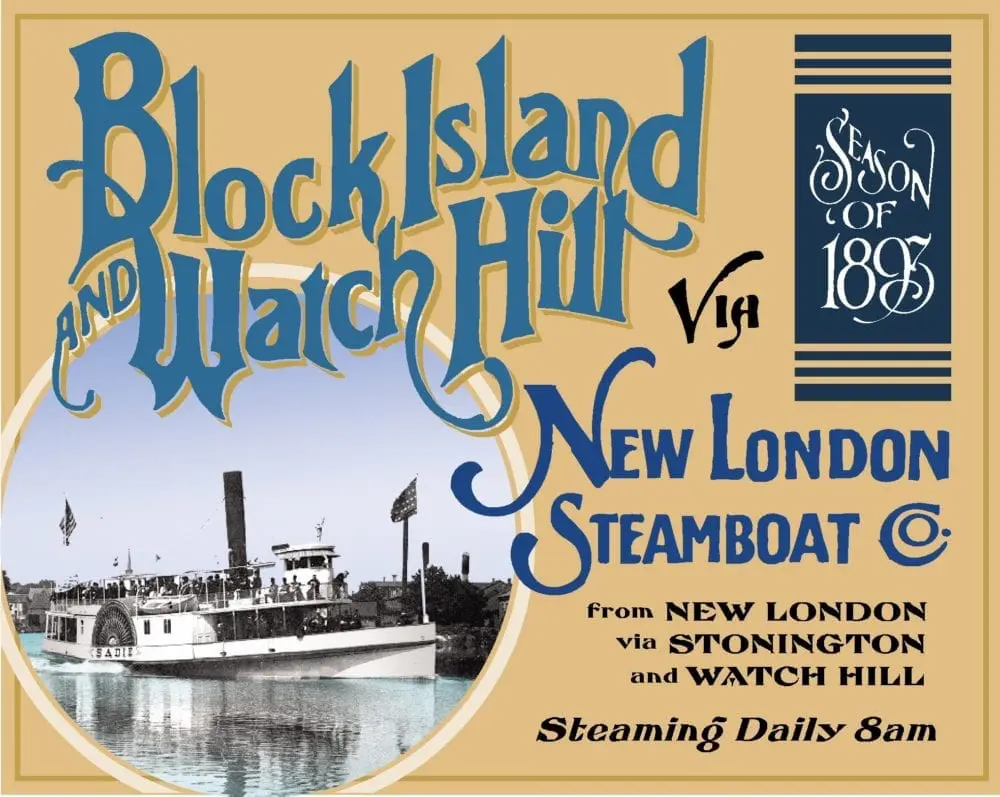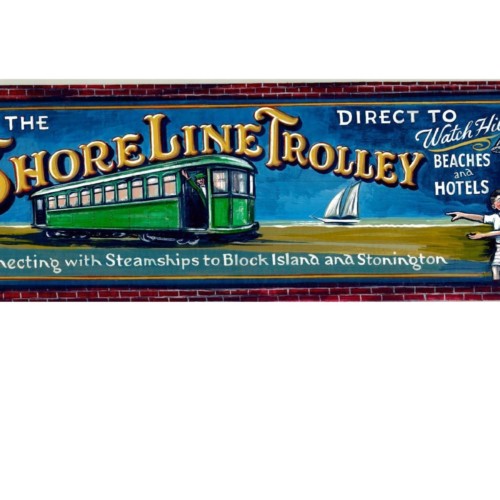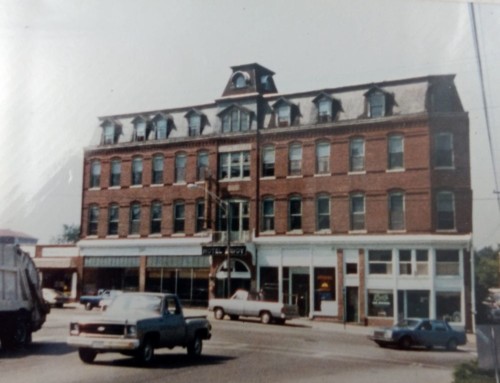The following is part four in Westerly Life’s “Behind the Murals” series discussing the history behind all the recently created murals throughout downtown Westerly. The New London Steamboat Company Mural discussed below is on the side of the Savoy building and can be best viewed from the intersection of High Street and Canal Street in downtown Westerly and the Shore Line Trolley Company Mural can be seen when exiting downtown Westerly via Canal Street. Given that the histories of both modes of transportation are deeply interconnected, this entry will discuss the story behind both murals.
Although the mural representing the New London Steamboat Company is devoted to the season of 1893, the story of pedestrian steamboats in Westerly began long before that. In 1868, Dixon House Square, the home of the Rhode Island Hotel, was built in the heart of downtown Westerly.[1] The hotel stood for sixty years before it was destroyed in a fire on April 16, 1928.[2]
It was popular with visitors who enjoyed spending time at Westerly’s famed beaches, and for this reason, the steamship Belle was built to carry both hotel guests and Westerly residents to Watch Hill.[3] The Belle began making trips on Independence Day 1869 and made two round-trips each day for a fee of forty cents.[4]
During its 13 consecutive seasons of operation, the Belle became well-known among locals and visitors looking for a good time. In addition to Westerly and Watch Hill, the ship also made a stop at Osbrook Point, where Joseph Crandall, better known as ‘Osbrook Joe,’ operated dance halls, bowling alleys, dining halls and bars.[5] Occasionally, riders on the ship got out of hand, and assistance was needed so a system was developed to warn police in Westerly.
Just before the onboard band’s finale, the Belle’s whistle would blow four times as they approached the dock, and the police would be waiting to detain the rowdy individuals causing trouble.[6] It was also said that the ship carried rum in kerosene and molasses containers from Norwich, explaining how some riders could end up in such a rambunctious state by the time they arrived home.[7]
While the Belle was the first major steamboat to carry passengers to and from Watch Hill, there were many that came in the decades that followed. By 1888, Watch Hill was seen by outsiders from around the East Coast as a luxury summer village.
As a result, a growing number of carpenters, painters, and builders were required to work on the cottages and homes that were springing up in the area and the ship Queen City was purchased to shuttle workers back and forth. At the time, ships were making seventeen round-trips each day between Westerly and Watch Hill. According to the Providence Journal, this feat was “unequaled in history.”[8]
During the season of 1893, the year referenced on the mural, there were at least two boats in operation between Westerly and Watch Hill. One was the Surf City, which was operated by Captain George Greenman between 1890 and 1893.[9] The other was the Martha, named after Captain Greenman’s daughter, which was built at the dock at Cross and Main Streets and ran to and from Watch Hill in 1893 and 1894.[10] 1894 proved to be the beginning of the end for steamboat transportation to Watch Hill, as the Pawcatuck Valley Street Railway began operation that year and provided sudden competition for the steamships.[11]
The opening of the Pawcatuck Valley Street Railway in 1894 was the start of a new era in Westerly, and it led to trolley transportation becoming the preferred mode of transportation in the town for the more than twenty-five years.
The history of trolleys in Westerly is a complex one, with several companies operating between 1893 and 1929, and many of these companies merging or changing names. The story of Westerly’s embrace of the trolley begins in March 1893, when the Pawcatuck Valley Street Railway Company (PVSRC) was incorporated.[12] In 1894, the Company possessed a six-mile-long line between Westerly and Watch Hill that was built by E.P. Shaw and Co. of Newburyport, Massachusetts.[13]
At the time of its introduction, the trolley’s stated purpose was “to operate from the Westerly railroad station to Watch Hill for at least six months out of the year.”[14] In 1901, the company began operating with a new timetable to Watch Hill, with trains departing Westerly every half hour beginning at 6 a.m. and the last car leaving Westerly at 7:30 p.m. and Watch Hill at 8:15 p.m.[15]
By 1906, the company ran into financial difficulties and was sold to a group known as ‘Klingel, Smith, and Mansfield.’[16] On July 1, 1911, PVSRC was leased to another company which served the Westerly area, the Norwich and Westerly Railway Company.
Originally chartered in Connecticut in 1903, as the Norwich, Mystic, and Westerly Street Railway Company, the above-mentioned leaser of the PVSRC, was chartered in Rhode Island on March 13, 1906 as the Norwich and Westerly Railway Company (NWRC). On December 12, 1906, the railway, which “operated with fast cars, railroad roofs, double truck types, and high backed seats built by the Southern Car Company” opened a line from Norwich through Westerly which crossed the state line at White Rock and advanced into downtown Westerly.[17]
The fare for a trolley from Norwich to Westerly was thirty-five cents, which was divided into seven different zones, with each zone costing a nickel to travel between.[18] On August 1, 1907, the NWRC suffered their most serious accident at Avery’s Crossing near North Stonington when a passenger car and express car collided head-on. Three were killed and eight were injured in the collision.[19] In 1908, a Pleasant View extension was opened.[20]
The lease of the PVSRC on July 1, 1911 by the NWRC, resulted in the formation of the Norwich and Westerly Traction.[21] In December, the PVSRC property was purchased outright by the NWRC after the Norwich outfit had built an extension from “Mastuxet Brook through Atlantic Beach (now Misquamicut) to Weekapaug.”[22]
The next significant gain for the Norwich and Westerly Railway Company came on July 1, 1913, when they leased the Groton and Stonington Company’s holdings, creating a sixty-mile-long system stretching from Norwich to Westerly to Groton with branches which included Westerly, Watch Hill, Weekapaug, and Ashaway.[23]
The tracks in Westerly first entered across a bridge over the state line into White Rock, and then crossed Pierce Street on a trestle before rejoining street traffic on the corner of West and Pleasant Streets. Trains then followed West Street crossing the railroad tracks via a bridge and proceeded down Railroad Avenue to the Westerly Train Station. Past the train station, trolleys then followed the PVSR tracks up Canal Street to High Street and continued to Broad Street where it stopped at Dixon House Square.[24]
While the above-mentioned lines were crucial to the transportation revolution in Westerly, their dominance paved the way for their incorporation into a much larger system, the Shore Line Electric Railway Company (SLERC), which is featured in the newly created mural.
The SLERC was incorporated in 1905 and began operation in 1910.[25] In 1913, the SLERC began acquiring vast amounts of trolley tracks from companies including the Connecticut Company and the New London and East Lyme Street Railway Company. That same year, they gained stock control of the Norwich and Westerly Traction Company.[26]
On June 30, 1916, the SLERC merged all its holdings except the Connecticut Company, creating a system operating 200 trolley cars over 20 separate routes, encompassing more than 250 miles of tracks.[27] In addition to transporting passengers from town to town, the SLERC also conducted a package service, carrying packages up to 15 pounds at the same rate as a passenger fare.[28]
Although the company appeared dominant after all of their acquisitions, by 1919, it faced insurmountable struggles. A combination of financial difficulty, an accident on June 21, 1919, and an employee strike that same year resulted in the folding of the SLERC.[29]
The various leases and mergers created a unique set of issues for passengers including the numbering systems used for trolleys, which caused confusion among riders. At one time, in Westerly alone, there were no less than three trains using the numbers 20 and 24.[30] Despite this issue, the trolley system in Westerly still represented a welcome change, as both residents and visitors could travel to the beach and back quicker than ever before.
Prior to the middle of the 19th century, many Westerly residents found traveling to and from the beach to be a struggle given the distance between downtown and the shore. This trouble was greatly eased, first, by the use of steamboats between the heart of the town and its seaside retreat, and later by trolleys operating between 1893 and 1919. Steamboats and trolleys played a significant role in the growth and development of Westerly and allowed both residents and visitors to move more freely than ever before.
[su_accordion class=””] [su_spoiler title=”Footnotes” open=”no” style=”default” icon=”plus” anchor=”” class=””]
[1] Best, Mary Agnes, The Town That Saved a State: Westerly, (Westerly, RI, 1943), pg. 97.
[2] Best, 97.
[3] Best, 97.
[4] Barns, Everett, History of the Pawcatuck River Steamboats, (Westerly, RI, 1932), pg. 17.
[5] Barns, 19.
[6] Best, 97.
[7] Best, 98.
[8] Best, 99.
[9] Best, 98.
[10] Best, 98-99.
[11] Best, 99.
[12] The Marker, vol. 5, No. 3, December 1946.
[13] The Marker, vol. 5, No. 3, December 1946.
[14] The Watch Hill Life, July 12, 1894.
[15] Westerly Sun, June 9, 1901.
[16] The Marker, vol. 5, No. 3, December 1946.
[17] The Marker, vol. 5, No. 3, December 1946.
[18] Cummings, O.R. & Munger, Charles F., The Shore Line Electric Railway Company: Predecessor Companies, 13.2, (Warehouse Point, CT: August 1961).
[19] The Marker, vol. 5, No. 3, December 1946.
[20] Westerly Sun, June 29, 1908.
[21] The Marker, vol. 5, No. 3, December 1946.
[22] The Marker, vol. 5, No. 3, December 1946.
[23] The Marker, vol. 5, No. 3, December 1946.
[24] Cummings, O.R. & Munger, Charles F., The Shore Line Electric Railway Company: Predecessor Companies, 13.2, (Warehouse Point, CT: August 1961).
[25] Hilton, George W. and Due, John Fitzgerald, The Electric Interurban Railways in America, (Stanford, CA, 1960).
[26] The Marker, vol. 5, No. 3, December 1946.
[27] The Marker, vol. 5, No. 3, December 1946.
[28] The Marker, vol. 5, No. 3, December 1946.
[29] The Marker, vol. 5, No. 3, December 1946.
[30] The Marker, vol. 5, No. 3, December 1946.
[/su_spoiler] [/su_accordion]








